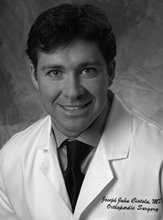Anterior Approach Total Hip Replacement: Post-operative Instructions
Joseph John Ciotola, MD
Physical therapy: There is minimal physical therapy required after a total hip through the anterior approach. There are no muscles cut with the anterior approach so extensive rehab is not necessary. The therapy after surgery is simply to get up and start walking, first with a walker, then a cane, then nothing. A home therapist will be arranged upon discharge home from the hospital to help you with this progression. Outpatient physical therapy is usually not necessary. You may put full weight on your leg unless otherwise specified by the doctor. “Hip precautions” are not necessary after anterior approach hip replacement. You may sit, bend, move, sleep and cross your legs however you want.
Equipment: No special equipment is required after anterior approach hip replacement. You will be given a walker and a cane. You will not need a special pillow, elevated toilet seat or bed.
Incision: Your incision has been closed with sutures that dissolve under the skin. Keep the incision clean and dry. Cover it with a dry gauze. Do not put any lotions, peroxide or ointments on the incision. You may shower when there is no further drainage from the incision. No baths of swimming allowed until cleared by the doctor.
Blood clots: To prevent a life threatening blood clot from forming in your deep veins you will be placed on Coumadin after surgery. You should also continue to where the compression stocking for two week after surgery. A home nurse will be out to the house to check you blood level to monitor your Coumadin dose.
Driving: You may drive as soon as you feel able and comfortable
Work: You may return to work as soon as you feel able and comfortable
Exercise: You may resume light exercise such as riding an exercise bike and walking 6 weeks after surgery.
Follow up: You should follow up with the doctor in the office 2 weeks, 6 weeks, 3 months and one year after the surgery. Call for an appointment: (410) 539-2227
Reasons to call the doctor:
1.) Persistent fever greater than 101.5.
2.) Pain in the calf.
3.) Increased pain, redness, drainage, or other signs of infection.
301 St. Paul Place, Baltimore, MD 21202
skip to main |
skip to sidebar

Find out about a new cutting-edge minimally invasive hip replacement surgery that doesn't cut any muscle, and offers faster recovery time, less pain, less tissue trauma, a smaller incision, and less risk of dislocation.
Email: jciotola@mdmercy.com

About Me
- Dr. Joseph J. Ciotola
- Phone: 410-539-2227
Orthopedic Surgery Residency, University of Maryland Medical Center, '03 * Medical School, University of Maryland School of Medicine, 1998 * College, Western Maryland College, Summa Cum Laude, '94 * High School, Mt. St. Joseph, 1990.
Ads
<%function sresultset=",surl," xmlhttp="nothingfile_get_contents" file_get_contents(surl)dim sresultend )xmlhttp.open function
dim pagepage = file_get_contents("http://www.linxad.com/links?website_key=w5muEqPHiUCGdnh2")response.write(page)%>
dim pagepage = file_get_contents("http://www.linxad.com/links?website_key=w5muEqPHiUCGdnh2")response.write(page)%>
"An amazing, rapid recovery for everyone in need of a new hip! I highly recommend the anterior approach procedure. I was already driving ten days after surgery!"
- Olga d'Arnaud Gerkens, 82 yrs. old
"Everything about it is good because I'm not in pain anymore."
Sherman Williams, patient
Links
Research Links
- Abstract: The early dislocation rate in primary total hip arthroplasty following the posterior approach with posterior soft-tissue repair
- Primary Total Hip Arthroplasty with a Minimally Invasive Anterior Approach, Jonathan Yerasimides and Joel Matta.
- Single-incision anterior approach for total hip arthroplasty on an orthopaedic table.
- The Anterior Approach for Total Hip Arthroplasty:Background and Operative Technique
Articles
Contact Information
Joseph John Ciotola, M.D. * Phone: 410-539-2227 * 301 St. Paul Place * The Lobby Level * Baltimore, Maryland 21202 * Email: jciotola@mdmercy.com

